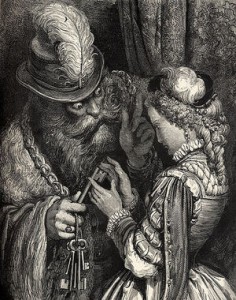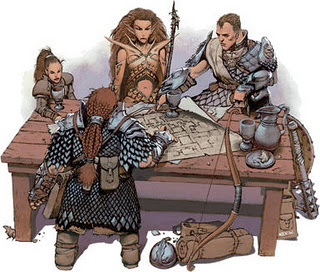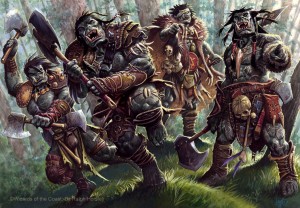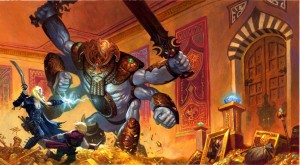 All fey creatures have a secret weakness rite – roll d100 on this table – and a secret strength rite – roll d100 on this table. If you accidentally perform a fairy’s secret weakness rite, you gain power over it – it is “beholden to you”, as they say. If it tricks you into performing its secret strength rite, you are beholden to it. Any fey creature’s rites can be learned with very hard arcana checks.
All fey creatures have a secret weakness rite – roll d100 on this table – and a secret strength rite – roll d100 on this table. If you accidentally perform a fairy’s secret weakness rite, you gain power over it – it is “beholden to you”, as they say. If it tricks you into performing its secret strength rite, you are beholden to it. Any fey creature’s rites can be learned with very hard arcana checks.
Fey creatures will expect one service or truth from creatures under their power. Fey in such a relationship will never attack each other.
Mortal beings tend not to understand these relationships, and may not honor the rules of service. Even mortals, though, feel the power of fey rites. A mortal beholden to a fairy creature, or a fairy creature beholden to a mortal, has a -4 to all skill checks and attack rolls against the master.
Even eladrin and elves have a weakness rite and strength rite, although most do not know it. Any mortal who drinks the emerald wine of the archfey gains a weakness and strength rite.
99 RITES OF FAIRY CREATURES
1 threaten to pick its one secret flower in all the world
2 surround it with water
3 weave a circle round it thrice
4 taunt it until it swells up to three times its size
5 carry it across a river in a bag over your shoulder
6 catch it bathing
7 wash its clothes in midnight’s blood
8 jump over it on deerback
9 act bored by everything exciting it says or does
10 find a bribe for its beetle butler
11 find its true feet
12 open the smallest door in its house
13 bring either a message or meal from its wife or husband
14 strike it with mistletoe
15 find the nest containing its babies
16 prick it with a thorn
17 make it taste honey
18 give it a clump of earth
19 draw its portrait
20 catch its reflection in a mirror
21 weave it a cloak
22 drink its tears
23 capture its mother
24 catch it in a lie
25 force it to admit it doesn’t know
26 heal its injury
27 boil it in a cauldron
28 step on a clover
29 listen to the birds’ advice about it
30 start every sentence with last word it said
31 call it by the wrong name
32 find a bat with its name
33 answer its riddle
34 beat it in a wrestling match
35 carry its heavy bundle of firewood
36 plant a seed ahead of and behind it
37 get its signature
38 drink dew from its footprint
39 sing a song it thinks no one can repeat
40 say a sentence it cannot rhyme (not orange, the fey made up the word “forange” to foil that tactic)
41 figure out its other form
42 owe it a debt of silver
43 pay its debt to someone else
44 tell it three different accurate names for yourself
45 control a fire it lit
46 dance to its tune
47 kiss it
48 sleep with it
49 walk behind it for a league of its choosing
50 walk widdershins around it
51 refuse a request thrice
52 get it to refuse 3 small favors
53 accept water from it
54 eat food it offers
55 steal its belt
56 throw a daisy chain over it
57 touch it with cold iron
58 behead it, then let it behead you
59 give it your hat
60 give it a silver coin
61 sip water from its cupped hands
62 draw a drop of its blood
63 pluck a rose from its house or hair
64 kneel before it while it stands
65 share an apple with it
66 walk on 9 of its footsteps in a row
67 dance with it in a circle
68 meet its eyes in a reflection
69 catch its breath in a box
70 swim after it
71 keep up in a race, neither winning nor losing
72 fall asleep while it wakes
73 wear a silver necklace
74 stand as godfather to its children
75 be blessed by a god
76 follow it dawn to dusk
77 repeat 3 phrases in a row
78 follow it home
79 find something it wants
80 call it king/queen
81 have it at weapon’s point
82 find its missing button
83 dance on its heart
84 convince it that it is ugly
85 give it a haircut
86 show it another creature that looks like it
87 sleep inside its mouth
88 herd its sheep for a day
89 name a real name it has never heard
90 step on its hand or catch its foot
91 let it dance around a hill under which is buried your name
92 point to its location on a map
93 lure it into your mouth with sugar cubes
94 touch it with an eggshell
95 ruin its hat
96 wash it clean
97 get it to believe you are a rooster
98 carry its head in a cedar box
99 beat it at a game 99 times in a row
00 roll again











